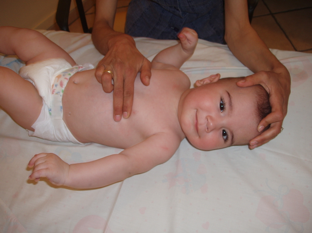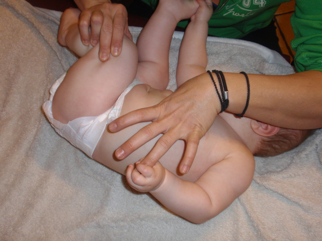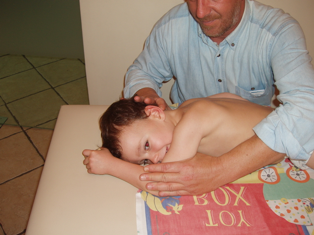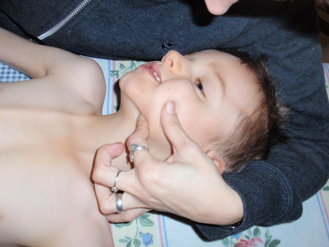Vojta
Contact
-
Adrianoupoleos 11A,
Kolonos, Greece
+30 210 51 29 504
Vojta Therapy
Diagnosis and evaluation follow therapy. Vojta's therapeutic proposal is called Global Reflection Mobilization. As her name says:
Global is called because during its application it includes the whole body and its functions (vision, chewing, swallowing, speech, breathing, digestion, defecation, diuresis, etc.).
|
|
 |
 |
 |
Reflective because the activation of the central nervous system is caused in a reflexive way
and
Mobilization γbecause kinetic responses belong to specific kinetic patterns known in advance in the patient's Central Nervous System.
In the Global Reflexive Mobilization, the therapist places the patient in specific positions depending on his / her kinetic state (kinetic age) and applies specific pressures, at a specified time and intensity, at defined points located in the head, torso at the upper and lower limbs. For each person, regardless of age and condition, the combination of position and pressure automatically and unintentionally causes, without participation, motor responses
Movements are caused by reflexes
The patient's kinetic responses are known to the physiotherapist in advance, they appear every time they are triggered, and they are all about the body.
The therapeutic use of spherical reflex mobilization makes patients with motor problems of nervous or musculoskeletal aetiology capable of repairing all or part of the lesion
With Global Reflexive Mobilization, a synchronized and rhythmic activation of all muscles and a response from various levels of central nervous system control are induced. The kinetic responses caused by the therapist can be reproduced as often as desired to the patient.
All movements that occur in normal kinetic growth such as: conception, rolling, bustling, sitting, buzzing, quadrupeding, upright and bipedal walk are evidently triggered depending on the motor age of the patient.
With the use of the Global Reflection Mobilization therapies, the movements that are necessary in his everyday life are involuntarily reflexive. The repetition of the exercises turns the involuntary-reflective motor responses into spontaneous movements initially into the spine and then to the head at the upper and lower limbs.
At each session, the patient is fully energized throughout his or her body. Immediately after each session there are changes, attitudes and movement, breathing, speech, etc., closer to the normal patterns that the patient is taking.
The repetition of these patient's motoric responses, through repeated stimuli, leads to release and the creation of new pathways to the functionally blocked circuits that connect the brain to the patient's spinal cord.
The difference between the method and other methods of physiotherapy
Vojta therapy activates the central nervous system until its higher level (cortex) reproduces normal responses that it already knows. Activation of the nervous system is caused by multiple stimuli from the periphery.
The Vojta method is the only one that reaches the brain and activates it so that it responds based on its capabilities. In this way the patient is not trained in learning movements or in locally and transiently restraining spasticity or any malfunction, but in creating the conditions for a more normal movement across the body. By physiological movement, we refer to movements that are more functional and more economical due to synchronized and coordinated muscular function.
ΜBy applying the therapeutic exercises of the spherical reflex mobilization, certain functions can be activated and influenced in parallel with the kinetic sequences such as:
• Convergence of sight (visual).
• Lower jaw movements and tongue (orthopedic mobility)
But also reactions of the plant nervous system such as:
• Bladder control
• Breathing
• Chewing and swallowing
• Sweating
• Disorientation
At the end of each session, reflex responses are able to be partially reproduced by the patient. With systematic repetition, "normal mobility" is memorized by the brain and is a new substitute for mobility closer to the physiological that the patient really wants.
The teacher's treatment can be applied to all ages. Newborns and infants are about the same, while children and adults can participate during exercise.
Treatment with the Vojta method has no contraindications, on the contrary its implementation contributes:
• The change in reflex activity and the orientation of neuro-motor function in directions closer to normal by the introduction of a different neurological activity that enhances the physical perception of the patient.
• The change of spinal automations in spinal cord injuries
• Controlling breathing and increasing vital capacity
• To control neurophystic reactions and to promote harmonic development of the motor system
• To prevent orthopedic lesions that often occur in pathological conditions.
Global reflex mobilization is a very effective treatment for central nervous system disorders. Unlike other forms of physiotherapy, it does not tire the patient, it can be used in cases where:
• lack of cooperation between a patient and a physiotherapist (new born and infants, intensive care unit or incubator in infants, people with low vision, etc.)
• people with heart or blood pressure problems
• people with already established pathological kinetic patterns and
• where there is pain
The duration of each session varies according to the age and condition of the patient. For the same reasons, the frequency of repetitions also varies. The treatment is done by the physiotherapist, but also by the patient's family environment, which is trained by the physiotherapist.
This form of treatment can be performed without a learning effort because the patient does not need to learn or participate. The new item is spontaneously entered with automatic activity.
The Vojta method is a dynamic form of treatment because it does not teach the patient positions or movements but makes him MANUFACTURER OF HIS OWN MOBILITY
